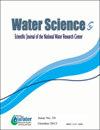Investigating the quality of groundwater in Ibeju-Lekki Local Government Area, Lagos State
Q2 Environmental Science
引用次数: 0
Abstract
ABSTRACT This study assessed the groundwater quality in the rapidly urbanizing peri-urban region of the Ibeju-Lekki Local Government Area in Lagos State, Nigeria, during the rainy season. This study employed a two-stage sampling technique to select representative sampling locations, including boreholes and hand-dug wells. Seven towns in Ibeju-Lekki were sampled for this study. A total of 14 sampling points were chosen for the analysis of 15 water parameters, which included five physical parameters (NTU, TCU, E.C. TDS and TSS), eight (8) chemical parameters (pH, T.H. Ca, Mg, Cl-, NO3-, SO42- and Fe), and two (2) microbial parameters (E.Coli count and BOD) after standard procedures. The data obtained were subjected to statistical analysis using Python to assess correlations between the physicochemical parameters. The results were compared with water quality standards set by the World Health Organization (WHO) and the Nigerian Standard for Drinking Water Quality (NSDWQ). In addition, a water quality index (WQI) was calculated to provide a single numerical expression of the overall water quality. The findings revealed variations in the quality of borehole and well water, with some parameters exceeding the recommended standards, such as magnesium and iron concentrations. The presence of elevated turbidity, total dissolved solids (TDS), and electrical conductivity (E.C.) in well water indicated potential contamination sources. The study also demonstrated the significance of understanding physicochemical parameter correlations in groundwater quality assessment. The WQI results emphasized that groundwater is suitable for various purposes, including animals and other domestic and agricultural purposes. However, the paper recommended routine monitoring and thorough treatment to address the high magnesium (Mg) and iron (Fe) levels in both borehole and well water sources.调查拉各斯州 Ibeju-Lekki 地方政府辖区的地下水质量
摘要 本研究评估了尼日利亚拉各斯州 Ibeju-Lekki 地方政府辖区雨季快速城市化的城郊地区的地下水质量。本研究采用了两阶段采样技术来选择具有代表性的采样点,包括井眼和手挖井。本研究对 Ibeju-Lekki 的七个城镇进行了取样。共选择了 14 个采样点,按照标准程序对 15 项水参数进行分析,其中包括五项物理参数(NTU、TCU、E.C. TDS 和 TSS)、八(8)项化学参数(pH、T.H. Ca、Mg、Cl-、NO3-、SO42- 和 Fe)以及两(2)项微生物参数(大肠杆菌计数和生化需氧量)。获得的数据使用 Python 进行统计分析,以评估理化参数之间的相关性。结果与世界卫生组织(WHO)和尼日利亚饮用水质量标准(NSDWQ)规定的水质标准进行了比较。此外,还计算了水质指数 (WQI),以提供整体水质的单一数值表达。研究结果表明,井眼水和井水的水质存在差异,一些参数超过了建议标准,如镁和铁的浓度。井水中的浊度、溶解固体总量 (TDS) 和电导率 (E.C.) 升高,表明可能存在污染源。这项研究还表明,在地下水质量评估中了解物理化学参数的相关性具有重要意义。水质指数结果表明,地下水适用于各种用途,包括动物及其他家庭和农业用途。不过,论文建议进行常规监测和彻底处理,以解决井眼和井水水源中镁(Mg)和铁(Fe)含量过高的问题。
本文章由计算机程序翻译,如有差异,请以英文原文为准。
求助全文
约1分钟内获得全文
求助全文

 求助内容:
求助内容: 应助结果提醒方式:
应助结果提醒方式:


